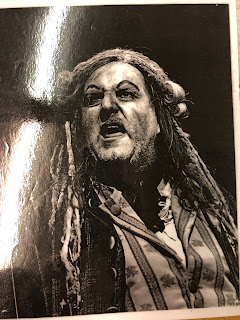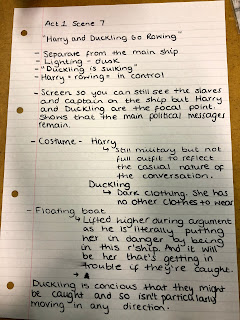Gestus
At the start of the lesson, we had a short discussion about the elements of Brechtian Theatre that we had found out about last week. This also gave us the opportunity to feedback any research that we had found out about Brecht and his style. Majority of what people had found out was the same as me and so we had the chance to talk it through as a group and help everyone understand his style a little more.
We then moved onto talking
about the Brechtian style piece that we did the week before as we had done some
more researched outside of the lesson and therefore could comment on some
improvements with a more educated mindset.
- Stereotypes. We did use stereotypes in our piece last week, but we needed to make sure that they were all on the same level in terms of accuracy and also intensity. We concluded that sometimes it is alright to have real characters, like Alexis and Connie’s characters, so that they can highlight the idea that everyone is surrounded by stereotypes and it is hard not to get caught up in them. I think that we could use this idea to our advantage especially with the scene being so political and have those real characters express their views in a realistic way.
- Creating process. Whilst we were in the creative phase with this scene, our core thought process probably wasn’t about the political message of the scene, which it should have been, but more about the hierarchy and who was interacting with who, due to the topic that the discussion was about.
Moving on from the scene that
we had previously looked at, we started talking about another technique of
Brecht’s that we had partially touched on last week which was Gestus. Brecht
said that he wanted to pick a scene from any part in a play and be able to
pause it and, from that specific point, be able to understand the political
motives behind the actions of the characters onstage. To help us understand the
idea of Gestus more, we decided to relate it to Stanilavski style, as we have
done production in that style before. We compared it to a moment of orientation
where you learn the relationships between characters onstage but with Brecht,
you learn about the political background to the scene. Or in perhaps an easier
sense, a freeze frame. He wanted to be able to see the political arguments that
are going on as well as the political motives behind the actions.
We then did a small task in
pairs where we thought of 4 things that, if we were doing a piece on slavery,
would indicate that slavery was the political message behind the scene. In my
pair we came up with:
- Chains. Both the sound of them rattling and the visual reminder of them always being there can remind the audience that no matter what the topic of the scene is there would still be slaves that are being mistreated somewhere in the background.
- Levels to reflect hierarchy. We thought that because there was a clear divide between the slaves and those in power we could make the staging reflect the status of those in the scene. Those who were higher up would therefore have the most power during the scene.
During some of the scenes,
there would be a moment of stillness or a slowing down of movements so that the
audience would be able to take that opportunity to understand and think about
the actions of those in the scene in relation to the political message. The
root cause when making a scene or a play in a Brecht style should be what the
political message is and making sure that the audience don’t get distracted by
their emotional connections to the characters, but they’re still engaged with
the performance in terms of realistic behaviour onstage.
We decided to compile a list
as a group of different examples of Gestus which we could relate to Our
Country’s Good.
Splitting them into the columns allowed us to recognise that there are many different types of Gestus and we have a wide range of elements that we could add into a scene. We then proceeded to find a scene that we could add clear elements of Gestus to and we found that finding ways to add in Gestus in the actual script was quite hard. We had to think not just about the lines and the characters, but about the props, set and the bigger picture regarding a scene. We also decided to think about putting on this play on a bigger scale than which we would be able to afford and so we decided to use staging as big as “The Tempest” which we went to see at the Barbican theatre in London last year.
Splitting them into the columns allowed us to recognise that there are many different types of Gestus and we have a wide range of elements that we could add into a scene. We then proceeded to find a scene that we could add clear elements of Gestus to and we found that finding ways to add in Gestus in the actual script was quite hard. We had to think not just about the lines and the characters, but about the props, set and the bigger picture regarding a scene. We also decided to think about putting on this play on a bigger scale than which we would be able to afford and so we decided to use staging as big as “The Tempest” which we went to see at the Barbican theatre in London last year.
In our pairs, we each picked a
scene and discussed the staging, props, lighting and characters that we would
set up as directors. We chose the scene right at the beginning of the play:
“Act 1 Scene 1”. This was on board the ship with the slaves at the bottom of the
ship whilst they were witnessing a whipping of a fellow slave. The scene
involves a mixture of characters who each speech about topics that are
unrelated to each other as they have been confined in a small place for a very
long time and it has started to affect their mental health which is evident
through the syntax of their speech. We decided that we would have a layered
staging so that we could show the idea of a boat and reflect the hierarchy
involved between the officers on board and the slaves. We decided to have the
whipping taking place on the highest level as that would be on the deck of the
ship and so we wanted there to be an almost harsh white light being focused on
them. In juxtaposition to this, we would have the slaves on a lower level with
quite dark lighting with the slaves only just being seen whilst they are
talking. We would also have the British flag flying on the mast on the main
deck and have all officers onstage with flags embroidered onto their uniforms
to highlight that Great Britain was involved in the slave trade and highlight
the disgusting measures in which the slaves were being treated by the officers
on board. This is a sketch of what we wanted our set and staging to look like:
Here are some pictures of the
other groups staging as well.
I found the Act 2 Scene 2, which is the last picture, interesting as the staging in which we were discussing had an officer at downstage right and a prisoner at downstage left with Ralph, the officer leading the rehearsal, in the middle. As a director, and thinking of it in terms of Brecht, I would use this to show Ralph trying to form relationships with the convicts that would allow them to listen to him so that the play could go ahead. Having him positioned in the middle of the two opposing sides could be seen as him trying to blur the lines between the two classes of people.
We were then given a series of pictures, and we had to decipher which ones were from a Brecht play and which ones weren't. Included in the pictures was the "Silent Scream" which we had looked into previously and we already knew was from a Brecht play called "Mother Courage and her children." After discussing which ones we thought fit the Brechtian category, we were then told that they were all from a Brecht play called "The Threepenny Opera".
I found the Act 2 Scene 2, which is the last picture, interesting as the staging in which we were discussing had an officer at downstage right and a prisoner at downstage left with Ralph, the officer leading the rehearsal, in the middle. As a director, and thinking of it in terms of Brecht, I would use this to show Ralph trying to form relationships with the convicts that would allow them to listen to him so that the play could go ahead. Having him positioned in the middle of the two opposing sides could be seen as him trying to blur the lines between the two classes of people.
We were then given a series of pictures, and we had to decipher which ones were from a Brecht play and which ones weren't. Included in the pictures was the "Silent Scream" which we had looked into previously and we already knew was from a Brecht play called "Mother Courage and her children." After discussing which ones we thought fit the Brechtian category, we were then told that they were all from a Brecht play called "The Threepenny Opera".
The Threepenny Opera is a "play with music" written by Brecht which is based on an English Ballad opera called The Beggar's Opera. Brecht once commented on the play at a concert performance that "You are about to hear an opera for beggars. Since this opera was intended to be as splendid as only beggars can imagine, and yet cheap enough for beggars to be able to watch, it is called the Threepenny Opera." It focuses on the lives of a group of beggars being lead by Macheath, also known as Mack the Knife, who marries Penny Pechum which displeases her father. He sets out to have Mack hanged and the story evolves from there. It has been performed at the National Theatre and one review said that it included "enduring fascinations and a timeless appeal for the bold satirical strokes of this malleable story of lowlifes, criminality and justice. The particular joy of the Brecht/Weill version, of course, remains its insinuatingly dark musical score, pulsing with brass, strings and harmonium sounds, and rendered here with stunning elan under the musical direction of David Shrubsole for his onstage band." (https://www.londontheatre.co.uk/reviews/the-threepenny-opera-review)
We then split into 3 groups and did a more detailed account of the set and staging for a different scene than we did earlier. In our group we did Act 1 Scene 7 which is when Harry and Duckling go fishing.
As we were making the set for the scene, we wanted to keep both the political message behind the scene, hence the slaves still being seen, to remind the audience of what is happening on a bigger scale of things and also we wanted the elements of Gestus that we had discussed previously to be involved which is in things like the addition of the Great British flag and the military uniform.
Here are the other scenes that people were staging:
I think that all of the staging that was proposed kept the political aspects very clear and they all included different areas of gestus.

















No comments:
Post a Comment